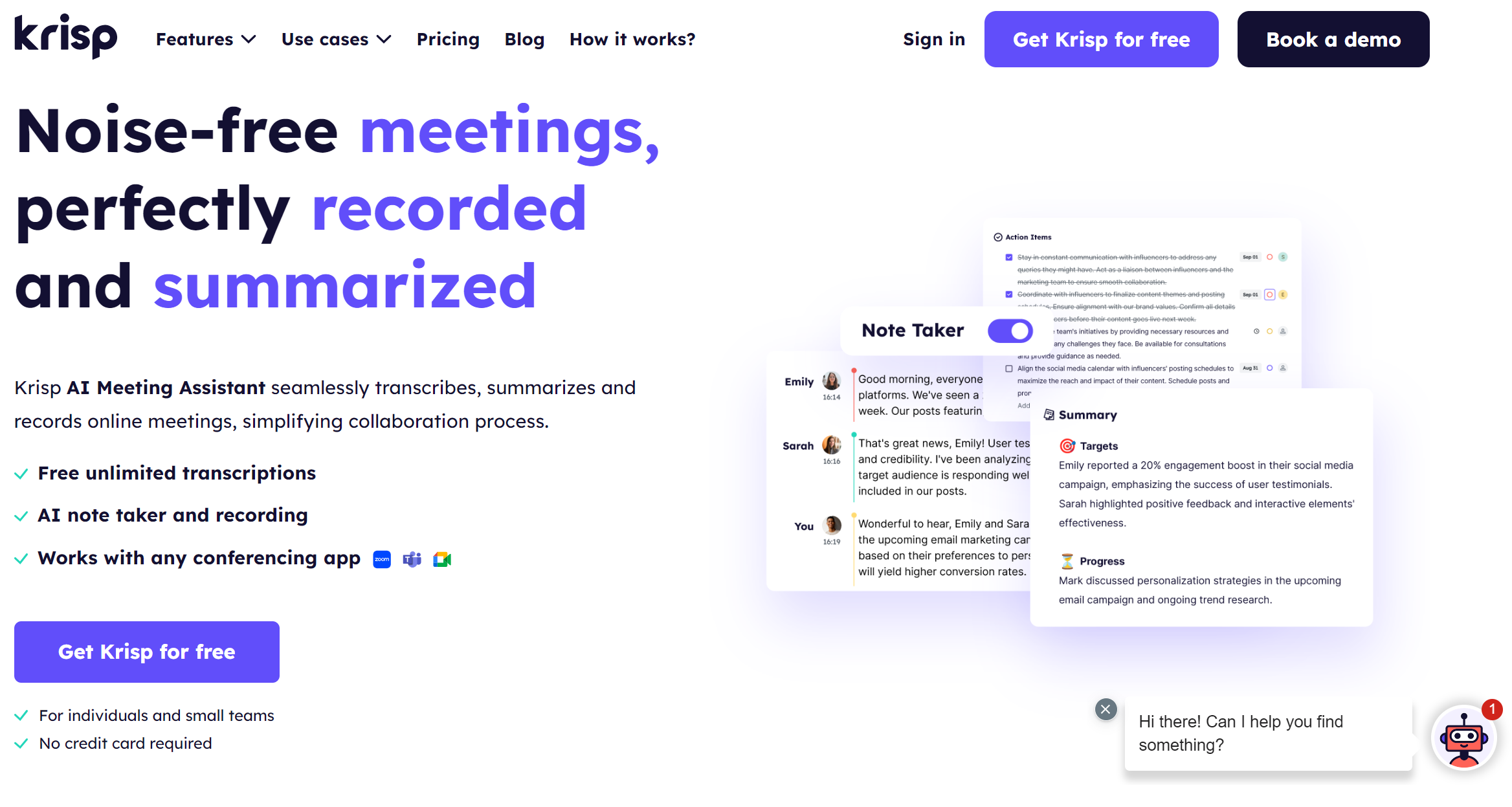Haven’t you walked into an office and felt the buzz of energy, kindness, and positivity in the air? That’s the magic of team morale boosters at work!
When the team feels valued, motivated, and happy, productivity soars, creativity flows, and everyone is ready to tackle challenges head-on. And since we spend most of our lives working, second only to sleeping, workspace morale is especially critical.
This article is about the team morale meaning, why team spirit can lower, and the essential tried-and-true strategies to boost it. Importantly, it tells the growing role of technology, like the Krisp AI Meeting Assistant, in boosting team spirit.
What Is Team Morale?

American Psychological Association defines “morale” as “the level of enthusiasm, sense of purpose, or confidence in the worthiness of a goal that can affect a person’s or a group’s overall performance in working toward that goal, especially when under pressure.”
Morale is vital in determining the process of task completion, its quality, and timelines. An example is a team celebrating a project milestone together, making them feel valued, motivated, and enthusiastic. As a result, team members enjoy increased productivity and collaboration.
And what is a synonym for team morale? Team spirit is another word for morale in the team.
- What is the difference between team morale and moral? The former concerns team spirit, which impacts productivity and collaboration. And the latter refers to ethical values like honesty, integrity, and respect.
- Who is responsible for team morale? Leadership is primarily responsible for maintaining team spirit but requires collective effort. So, every team member plays a role by supporting each other, contributing to a positive culture, and providing feedback.
- What is good team morale? Good or high morale reflects a harmonious, motivated, productive, and collaborative workforce. This results in camaraderie, mutual respect, and collaboration and encourages high performance.
- What is poor team morale? Low team morale reflects a hostile, disengaged, unproductive team with a high turnover. It causes the team to lose optimism about their efforts toward common goals or tasks.
Why Is Team Morale Important?
Spirit can make or break teams. So, building team morale is critical to creating an ideal work environment that motivates employees.
McKinsey’s research on people and organizational performance reveals that dependable and committed team members value meaningful work, flexibility, and supportive coworkers open to collaboration. And additional compensation isn’t the primary motivation for these individuals.
However, unfairness is the leading cause of demotivation. Did you know unfairness is one cause of low team morale, a common workplace issue? That’s why learning how to build team morale is vital in addressing this issue.
Thankfully, managers can check team morale to prevent disharmony in work environments. And we’ll discuss this below.
Team Morale Benefits
First, let’s uncover the undeniable role of high team spirit and how it affects employees and organizations.
1. Increased Productivity
Employee morale plays a decisive role in productivity and retention. And happy employees work harder and show higher motivation and enthusiasm.
2. Growth and Development
A toxic work environment with threatening behavior accounts for over 60% of hostile workplaces with no sustainable, inclusive growth. Such behavior includes harassment, discrimination, bullying, aggression, and abuse.
3. Better Collaboration and Teamwork
Good team morale builds camaraderie and team synergy. And these lead to effective collaboration and teamwork in the workspace through effective communication.
4. Higher Engagement
The McKinsey research mentioned shows that a median-size Standard and Poor’s 500 (S&P 500) company could lose $228-$355 million yearly due to employee disengagement and attrition. The S&P 500 is the stock performance tracker of the largest 500 companies on the US stock exchanges.
5. Enhanced Creativity
2015 SCIRP research shows positive thinking and job satisfaction enhance the inspirational experience. Specifically, the happier ones are the most creative and innovative in the workspace.
6. Reduced Stress and Improved Well-Being
Great management can improve mental health. Unfortunately, stress is rising worldwide, causing a rapid increase in incivility at work, as Georgetown University professor Christine Porath notes.
7. Increased Retention
After facing the Great Resignation of 2021 caused by cooling economic and job markets, retention is more vital than ever. Did you know employees’ long-term commitment to companies is currently the lowest in nine years? Thankfully, employee turnover is preventable.
8. Stronger Company Reputation
A business’s reputation is based on its products or services and how it treats its employees and customers. Naturally, a lousy company reputation can ruin and damage the public perception of a brand. That’s why good morale is essential in the reputation management of teams and businesses.
9. Career Advancement
High team morale suggests member recognition and career advancement to acknowledge their hard work and contribution. Importantly, career development opportunities create happiness, retaining employees and making them feel valued and happy.
10. Improved Decision-Making and Bottom Line
Good team morale encourages members to generate new and innovative ideas and overcome challenges effectively without feeling left out of the loop. As a result, teams enjoy better decision-making. And effective decision-making, in turn, enhances job satisfaction and morale.
Reasons Why Team Morale Can Lower: Team Morale Quotes

Knowing how to boost team morale starts with understanding why team spirit can drop. Here are the main reasons:
1. Unfairness and Lack of Humanity
Lack of humanity and unfairness erode trust, increase stress and anxiety, and create a toxic work environment with high turnover rates. Thus, fair workspace, empathy, and open communication help teams maintain high morale, ensuring a positive, engaged, and productive workplace.
As Max De Pree, an American businessman and writer, said, “Toxic leadership is defined by lack of respect for human life, dignity, or rights.”
2. Poor Communication
Poor communication makes teams slow down. Why? Because it leads to poor collaboration and conflicts, lowers productivity and enthusiasm, and leaves issues unsolved. When team members feel uninformed about critical decisions, they feel frustrated, demotivated, and alienated.
Famous emotional intelligence expert Dr. Travis Bradberry said, “You can always recognize toxic leadership when team members feel disempowered or left out of decision-making processes.”
3. Lack of Recognition and Appreciation
Positive feedback based on work results is called recognition, and appreciation acknowledges individuals’ inherent value. When hard work goes unnoticed, team members lose motivation and excitement. Thus, implementing recognition programs like “Employee of the Month” noticeably improves team spirit.
American entrepreneur Jon Taffer said, “The greatest gift of leadership is a boss who wants you to be successful.”
4. Excessive Workload
Overworking and overwhelmed team members can lead to burnout, stress, anxiety, and lowered morale. Thus, balancing the workload and ensuring adequate breaks are essential. Specifically, hiring additional staff and encouraging regular breaks can help teams cope with burnout, boosting creativity and morale.
Mindfulness teacher and productivity coach Melissa Steginus said, “Remember that work and life coexist. Wellness at work follows you home and vice versa.”
5. Absence of Technology Facilitating Workflows
AI technology eliminates inefficient workflows and automates processes, reducing stress and eradicating burnout and worker frustration. For instance, the Krisp AI Meeting Assistant can enhance SOAP note example writing, eliminating burnout among medical professionals.
Dr. Navdeep Dhaliwal, Director of Clinical Informatics at Aarista, said, “By integrating Krisp‘s advanced AI Noise Cancellation technology, we are not only enhancing physician dictation accuracy but also revolutionizing telemedicine communication.”
6. Poor Management and Leadership
Unfair, unsupportive, and unclear leaders significantly dampen team spirit. Moreover, supervisors who discriminate and micromanage team members don’t encourage cohesion and motivation.
Simon Sinek, an American inspirational speaker on business leadership, says in “Leaders Eat Last,” “And when a leader embraces their responsibility to care for people instead of caring for numbers, then people will follow, solve problems and see to it that that leader’s vision comes to life the right way, a stable way and not the expedient way.”
How to Measure Team Morale
When team members are discontented, disengaged, and experiencing workplace burnout, it’s time to check team morale. Otherwise, you won’t be able to identify areas for improvement.
Here are effective methods to measure employee morale:
1. Team Member Surveys
Regular employee surveys enable gathering feedback on job satisfaction, work environment, and leadership. Specifically, anonymous surveys based on quantitative and qualitative questions encourage honesty.
Quantitative questions, also called rating scales, provide measurable data to better identify trends and patterns. And qualitative questions, also known as open-ended questions, offer deeper insights into team members’ thoughts and feelings.
Examples: “Using a scale of 1-10, describe how satisfied you are with your current job.” And “What do you think should be improved in your work environment?”
2. Pulse Surveys for Team Morale
Pulse surveys are short and frequent (e.g., weekly or monthly). They help quickly gauge real-time insights from team members, employees, customers, or stakeholders. Usually, these surveys include only five to ten questions and focus on specific workspace aspects.
Examples: “How do you feel about the level of communication in our team this week?” or “How motivated do you feel at work today?”
3. One-on-One Meetings
Regular one-on-one meetings are great for discussing feelings and concerns. But, the meeting environment should be safe and confidential.
Specifically, Krisp’s AI Meeting Assistant for Recording and Transcribing can help you focus on listening instead of taking meeting notes without missing any critical points.
Examples: A manager could ask, “How do you feel about your current projects and workload?” and “Is there anything you think we can do to support you better?”
4. Interviews with Employee Focus Groups
Employee focus group discussions let managers gain a broader perspective on morale. These discussions should include diverse participants from different departments.
Specifically, such small discussions enable delving into team members’ feelings to reveal whether they’re content and happy.
Examples: A focus group could discuss questions like, “What do you think are the biggest challenges we face as a team?” and “What changes would you like to see in our company culture?”
5. Objective Observation of Team Morale
Monitoring employee morale, behavior, engagement levels, and interaction changes is vital in measuring the spirit. This means observing signs of disengagement, such as decreased productivity, increased absenteeism, or lack of participation.
Importantly, it’s vital to observe objectively. And managers can do this by using the Krisp AI Meeting Assistant that creates objective summaries of online meetings, eliminating bias.
Examples: Low morale signs can include decreased participation during team meetings or social interactions among team members.
6. Employee Net Promoter Score
Employee Net Promoter Score (eNPS) is a scoring system that helps managers measure team member satisfaction and loyalty. It uses the Net Promoter Score system from Bain & Company, Satmetrix Systems, Inc., and Fred Reichheld. Specifically, eNPS means subtracting the percentage of detractors (0-6) from the percentage of promoters (9-10).
Examples: “Using a scale of 0-10, describe how likely you are to recommend our company as a workplace?” “Why did you give that score?” followed by “What improvements would make you more likely to recommend us?”
7. Suggestion Boxes
Physical or digital suggestion boxes enable team members to anonymously submit their thoughts, ideas, suggestions, and concerns. It’s critical to review and address their suggestions regularly, treating their comments respectfully. Moreover, it’s vital to communicate actions taken based on team members’ feedback.
Examples: A team member might suggest, “Can we have more flexible working hours?” or “It would be great to have more team-building activities.”
8. Benchmarking Against Team Morale Standards
Compare your employee morale metrics with industry standards or similar companies to see where you stand. Use industry reports and studies for accurate benchmarks. Look for best practices from companies with high morale.
For instance, the famous analytics and advice organization Gallup offers 12 employee engagement elements that predict high team performance.
Examples: “How does our employee satisfaction score compare to the industry average?” or “What practices do top-performing companies in our sector use to maintain high morale?”
9. Employee Engagement Platforms
Utilize specialized software platforms that offer surveys, feedback, and recognition tools to gauge and improve morale. Specifically, opt for the one that best suits your company’s size and needs. Moreover, regularly review the data and act on the insights regarding employee engagement.
Examples: Consider using Survey Monkey and Google Forms for surveys; TINYpulse and Officevibe for feedback; Bonusly and Kudos for recognition; and Slack and Zoom for communication.
10. Exit Interviews
Exit interviews discuss the team member’s reasons for leaving and the experience they’ve gained. This helps uncover insights into pain points that should be improved.
Specifically, a neutral third party should conduct these human resources meetings and focus on gathering consistent data. Notably, Krisp’s AI Note-Taker can help focus on the discussion instead of taking online interview notes.
Examples: “What prompted your decision to leave?” and “What changes could we make to improve employee retention?”
How to Boost Team Morale

Learning how to improve team morale requires a proactive approach and consistent effort. Here are the leading strategies and team morale activities for effective results:
1. Be the Leader You Wish You Had
Leadership isn’t about a title or rank. It’s about your influence. Today, when people face many stressors, empathetic and honest leadership in the workplace is more critical than ever.
Thus, be a relationship builder so people will eagerly speak up. Importantly, people feel whether you’re truly authentic or not. So, be humane, fair, and honest to ensure trust, loyalty, and respect.
Example: Microsoft’s CEO Satya Nadella made the company culture shift toward empathy, humanity, respect, collaboration, and employee well-being.
2. Foster Open Communication
To foster open communication, create an environment where team members don’t fear being judged. Thus, they’ll feel comfortable honestly sharing their ideas, concerns, and feedback.
Example: Google encourages employees to share ideas and feedback using different channels, including direct communication with executives. This transparency fosters trust and engagement.
3. Face Conflicts Head-On
The power of conflict resolution is undeniable. It helps avoid resentment and a toxic work environment, improves communication, and boosts transparency, mutual understanding, and trust.
So, confront conflicts immediately by being open to hearing and validating all points of view to understand where the conflict lies.
Example: Netflix managers use open feedback and transparency to resolve conflicts. They encourage employees to voice concerns directly and constructively to foster trust and prevent issues from escalating.
4. Recognize and Reward Achievements
Recognizing and rewarding hardworking team members for their achievements Is another step in learning how to increase team morale. For instance, employee recognition can include verbal praise, awards, bonuses, or a simple “thank you.” People love to be appreciated for their hard work.
Example: Retailer Zappos is known for its strong culture of recognition. The company regularly celebrates employees’ achievements with awards, bonuses, and public appreciation to keep employees motivated.
5. Promote Work-Life Balance
Provide a healthy work-life balance, encouraging team members to take time off to unwind and have flexible working hours. Did you know employees would quit rather than reject hybrid work? Additionally, offer remote work and ensure team members can take breaks.
Example: Google offers flexible work hours and remote work options. Thus, its employees manage their schedules to fit their personal lives better.
6. Invest in Team Building
Organize team-building activities with ice breaker questions to make relationships and camaraderie among team members stronger. For instance, consider team lunches and outdoor retreats.
Example: Team Outings Departments at Apple regularly organize dinners, outdoor activities, and cultural events. These outings help people bond and build stronger relationships outside of the office.
7. Provide Opportunities for Growth
Effective employee development opportunities, such as courses and seminars, contribute to career growth. Knowing how to build morale within a team also involves training programs and workshops and taking care of your team’s future.
Example: Apple offers various workshops, seminars, and online courses to help employees develop new skills and become more effective team players.
8. Encourage Team Autonomy and Freedom
Give your team the autonomy and freedom to make decisions, set goals, and manage their projects. As a result, they’ll develop a sense of ownership and responsibility, which will keep them engaged and excited about their work.
Example: Spotify uses its “Squad” model, which is focused on one feature area. In this case, small cross-functional teams (typically six to 12 individuals) operate independently, driving innovation and high employee satisfaction.
Cross-functional teams represent members from various departments working together to achieve a common goal.
9. Foster Innovation, Experimentation, and Creativity
Innovation and creativity are the cornerstones of growth and prosperity, making our days rich and purposeful. So, create a workspace open to experimentation, brainstorming, and idea-sharing.
How? Organize regular collaborative meetings and workshops or provide online collaboration tools like Meeting Assistant Krisp and the team communication platform Slack for hybrid work.
Example: The Microsoft Garage initiative opens up doors for experimentation and collaboration, enabling employees to bring their ideas to life. Specifically, employees get access to the latest technologies and a supportive community of fellow innovators.
10. Offer Team-Morale Support
Provide the necessary resources and support for added effectiveness, such as tools, training, and mentorship. When employees have what they need to succeed, they become empowered to work more productively and with higher job satisfaction.
Example: Microsoft offers extensive training programs, access to the latest technology, and a supportive work culture. As a result, employees enhance their skills and contribute to a positive, productive work environment.
11. Promote Physical and Mental Health
Happiness and productivity in the offices foster team morale and organizational excellence. Whether design or comfort, they inspire collaboration, impact member morale, and boost productivity.
Example: On-site amenities at Google’s campuses include gyms, swimming pools, nap pods, and wellness centers to help people manage stress and stay healthy.
12. Minimize Disruptions
Constantly working beyond scheduled hours and frequent interruptions outside of work, such as late meetings, hurt the work-life balance.
To minimize disruptions, reduce team members’ commuting time and let them plan their work hours to accommodate their personal priorities. Additionally, offer support to team members in how they want to be supported.
Example: Salesforce offers flexible schedules, generous parental leave, and wellness opportunities through its “Ohana Culture” program. Namely, this program promotes a supportive environment where employees’ personal lives are valued.
13. Create a Coaching Culture
High-performing organizations have coaching cultures. These cultures foster active learning, personal growth, and strong support systems within the company.
Specifically, active learning can include mentoring, training, and job shadowing. The latter refers to employees following and observing another employee’s performance to understand their role requirements and job tasks better.
Example: Google offers extensive coaching programs through its “g2g” (Googler-to-Googler) initiative, where team members coach and mentor each other.
As a result, they develop new skills, build confidence, become motivated, and strengthen relationships, which boosts job satisfaction and engagement.
14. Offer Fair Compensation
Fair and transparent compensation increases engagement more than providing additional pay. Thus, a fair-pay workspace boosts job satisfaction, drives employee engagement, and minimizes turnover.
So, make your compensation policy available for employees and candidates to see. Besides, tell them where they can go with their pay questions.
Example: Starbucks offers competitive wages, comprehensive health benefits, stock options, and college tuition assistance to ensure fair compensation and support.
Use AI Meeting Assistant Krisp to Boost Team Morale

As you read above, team spirit is based on factors that keep members happy, engaged, supported, and productive, raising the company’s reputation. And these factors are closely related to Krisp. First, let’s unveil this connection, and then, look at Krisp’s features behind the connection:
- Increased productivity and efficiency
Did you know AI technology can raise employee productivity by about 14%, according to the National Bureau of Economic Research? Moreover, Microsoft reports that at least seven in 10 survey respondents consider inaccurate data, inability to access and share decentralized data, and working from different data sets the top company challenges.
- Career advancement, growth, and development opportunities
About 91% of survey participants reported working remotely at least one or two days per week, according to Microsoft. And Krisp‘s role as a productive AI Meeting Assistant for remote collaboration is undeniable.
- Improved collaboration and well-being
Microsoft reports that approximately 85% of survey respondents wish their collaboration tools had more automation capabilities so they could spend more time on essential work.
- Increased engagement, creativity, and decision-making
According to Microsoft, nine out of 10 people seek simpler ways to automate daily tasks so they can focus on what matters most. And 87% of employees believe digital transformation is more vital now than ever.
How Krisp Helps Increase Team Morale

Krisp is designed to help leaders empower people for how work gets done to build team spirit. How?
Krisp Offers Automatic, Streamlined Audio Recording to Boost Team Morale
This AI Meeting Recorder automatically records your online interactions so you can stop worrying about missing critical discussion points.
You can save these meeting recordings for future reference. And you can revisit, review, and share them with others anytime so everybody is on the same page.
Krisp Offers Real-Time Noise Cancellation to Improve Team Morale
Krisp’s Noise Cancellation eliminates noise, voice, and echo from online interactions so you can enjoy peace of mind without burnout and stress.
Moreover, Krisp’s highest audio quality lets you focus on discussions instead of feeling fatigued, frustrated, and disconnected. Thanks to such smooth and efficient meetings, you can avoid guessing the speaker’s words.
Krisp Offers Unlimited, Multilingual Transcriptions to Build Team Morale
Krisp’s Meeting Transcriptions provide exceptional 96% accuracy so you won’t waste your valuable time on note-taking.
Instead, you can focus on what matters most and come up with innovative and creative ideas during online discussions. Also, you can access your transcripts anywhere, anytime.
Krisp Offers Meticulous Meeting Notes & Summaries to Raise Team Morale
Krisp’s Meeting Notes and Summaries feature unmatched accuracy and attention to detail so that you can avoid errors and unnecessary discussion points. As a result, you can have more time to spend on boosting your well-being and productivity.
As a result, Krisp:
- Boosts productivity and efficiency
- Contributes to growth, development, and career advancement
- Enhances collaboration, decision-making, and engagement
- Improves work-life balance and well-being
- Raises the company’s reputation.
Conclusion
Team morale encompasses attitude, satisfaction, well-being, and confidence and is vital for a thriving workplace. Boosting morale involves fostering open communication, recognizing achievements, and promoting work-life balance.
Moreover, it refers to investing in development, organizing team-building activities, improving the workspace, encouraging autonomy, and providing support.
Notably, technologies like AI Meeting Assistant Krisp enhance virtual meetings by eliminating noise and offering real-time transcriptions to make team members happier and more productive.
Frequently Asked Questions on Team Morale






